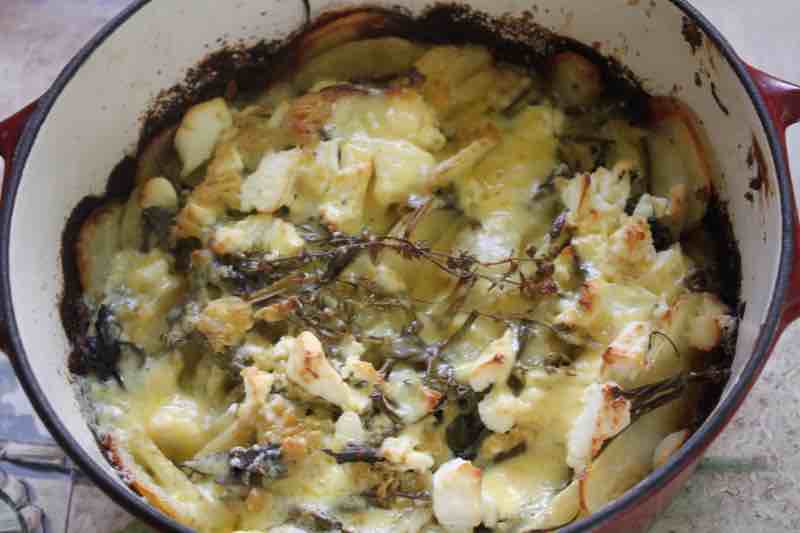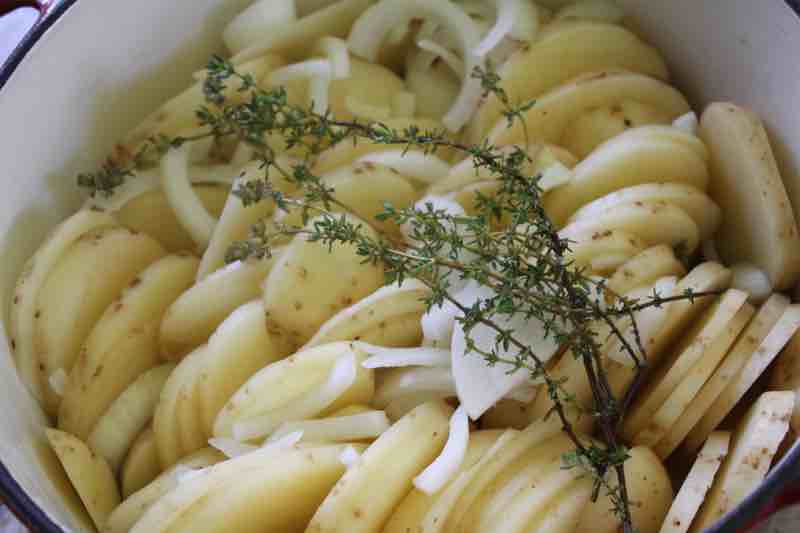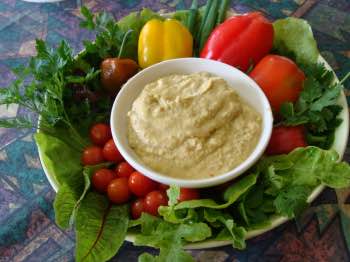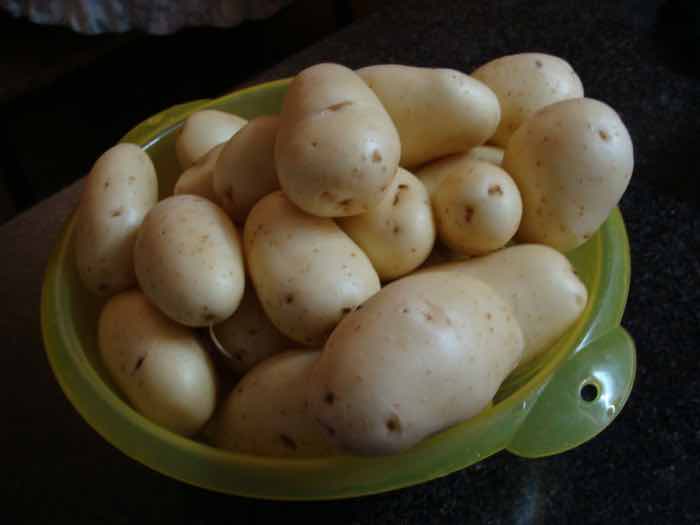- Bernard Preston homepage
- Our green kitchen
- Potato Gratin
Potato gratin
Potato gratin is just another way we have to enjoy new spuds recently harvested from our green garden. We have a glut right now in midsummer so we are eating less bread and cornmeal to keep our starches well under 150g per day.
Neither Helen nor I are obese but we still do minimise the carbs; the virus is nailing those with raised blood-glucose.

We only eat new potatoes. Those from cold-storage are certainly fattening; and in any case farmers use a nasty herbicide called Paraquat to kill off the haulm just before reaping. Traces are certainly found in the spuds. It's banned in many countries; and should be here too.
Many would suggest that I am on the edge of a food neurosis called orthorexia; I don't deny it. The upside is that our new potato gratin tastes better than any other and, having a full complement of fibre from the skins means we both have happy tums[2].
When you turn down an invitation to dinner because your hostess might have used this or that in her cooking, then you are indeed on the edge of this serious psychological disease. The green journey is full of pitfalls but so many blessings too; not least is a life without medication[3].
There is no need to peel new potatoes. You should be able to scrape the skin off with your thumbnail.
There are two ways to bake potato gratin and my advice is to try both; I am unsure whether there is any nutritional benefit of one over the other. Both methods start with washing your freshly-lifted spuds and slicing them thinly.
- Precook the slices in boiling water and then pop them in a hot oven.
- Bake the raw slices in cream.
Both methods have their merits.
So try both ways and see which you prefer. The ingredients are identical.
Potato gratin
Potato gratin means first slicing the spuds and pre-boiling them before popping the dish into the hot oven.
- 4 large new potatoes
- 1 medium-sized onion
- Large handful of chives
- 30g of grated strong-cheddar
- 30g of feta cheese, so no extra salt
- 100ml fresh or sour cream
- 50ml whole-cream milk
- 2 TBSP hummus, optional
- Freshly-ground black pepper; be generous
- A few sprigs of thyme, a couple seared peppadews or a chili
- Scrub the new potatoes and slice them into 3mm-thick rounds.
- Steam them for five-minutes in a minimal amount of water, and then drain.
- Cut the onion in half and slice into half-moons.
- Using a discarded butter-wrapper, grease an oven dish.
- Layer the potato slices and onion vertically in the oven-dish, periodically giving a generous grind of black pepper; add the sprigs of thyme.
- Sear a few peppadews, chop and add to the mixture.
- Sprinkle with chives and the feta-cheese.
- Mix the cream and hummus; add to the potato gratin.
- Cover with the top of the oven-dish.
- Bake in a hot oven for an hour.
- Sprinkle the grated-cheddar over the hot potatoes, add a few tablespoons of full-cream milk and place under the grill for a few minutes until the top has browned.
Using spuds that are not precooked is an option; if you want to be fancy the French call it Potatoes Dauphinoise, sometimes not even using cheese. The starch forms a thick creamy-sauce.
I particularly like using new potatoes because you can slice them thinly with a crunchy sound which you'll only recognise when you give up on those from cold-storage.
And secondly the combined effect of the new potatoes having less starch and the fat in the cream means this is unlikely to affect your blood-glucose. Nevertheless keep the portions small to limit the glycemic load. Being able to slice them thinly means they will cook faster.
Our motto is slow food, cooked fast; it must be tasty, nutritious and quick. You are actively busy for only half an hour. Not having to peel new potatoes is a huge saving in time and nutrients; much of the vitamin C is found right under the skin, for example.
Ever conscious of the effect of our dishes on the waistline we only eat new potatoes and limit the portion size; and have no other starches with the meal.

Your potato gratin has ample portions of starch, fat and protein but by all means enjoy it with a meat dish; and a brightly-coloured green salad.
If you are carrying too many pounds then I strongly recommend you learn about testing for pre-diabetes at home. If your blood glucose has not returned to around 6 two hours after the meal, then I would avoid potato gratin altogether. For you it's a killer; literally.
The sulforaphane for diabetics will help ameliorate the fear of this nasty disease; it's found in dark-green leafy vegetables. That is why we have them at least once a day and usually with every starchy meal.
 A divine green salad provides the fibre the tum desperately needs.
A divine green salad provides the fibre the tum desperately needs.Precooking
Precooking your potato gratin, either by boiling or in the microwave simply reduces the overall time in the oven. Remember important-nutrients may be lost in the water, so keep it to a minimum; or save it for some gravy.
Those using solar power must get the oven with their potato gratin properly hot before the sun's energy begins to fade; the lithium-batteries will cope with the intermittent heating needed thereafter.
Fibre
 No need to peel new potatoes; that's where much of the fibre is located.
No need to peel new potatoes; that's where much of the fibre is located.We need at least 30 grams of fibre every day from our food to satisfy the bugs in the colon; this undigested starch from our meals is what they feed on. Only 5% of folk in the Western world are meeting this criterion; it comes as no surprise that many suffer terribly from constipation and a host of bowel-diseases.
Your average potato, with the skin on will provide about 6 g of fibre[1]; it really is a good source. Now you know why we eat only new spuds; the peel is essential for a happy tum.
The optional hummus adds a little extra vegetable-protein and yet more fibre; it's all about making delicious, nutritious food with a low glycemic index.
We need have little fear of dishes that are high in fibre, fat and protein. It's the refined carbs that are the killers; and spuds from cold storage.
I learned from a diabetic patient that new spuds don't spike his blood glucose like those from cold-storage; the net carbs are much lower. Nevertheless test yourself after a helping of potato gratin.
Searing the chilies
We sear the chilies or peppadews on a fork over an open fire or in our woodstove; in much the same way you would toast a marshmallow.
- High-fiber foods for a healthful diet
- Health nut neurosis
- Life without medication. Web: https://tinyurl.com/3r22399e
When browsing use right click and Open Link in New Tab, or you may get a bad gateway signal.
Newsletter
Our newsletter is entitled "create a cyan zone" at your home, preserving both yourself and Mother Earth for future generations; and the family too, of course. We promise not to spam you with daily emails promoting various products. You may get an occasional nudge to buy one of my books.
Here are the back issues.
- Lifestyle and ideal body weight
- What are ultra-processed foods?
- Investing in long-term health
- Diseases from plastic exposure
- Intensive lifestyle management for obesity has limited value
- A world largely devoid of Parkinson's Disease
- The impact of friendly bacteria in the tum on the prevention of cancer
- There's a hole in the bucket
- Everyone is talking about weight loss drugs
- Pull the sweet tooth
- If you suffer from heartburn plant a susu
- Refined maize meal and stunting
- Should agriculture and industry get priority for water and electricity?
- Nature is calling
- Mill your own flour
- Bake your own sourdough bread
- Microplastics from our water
- Alternative types of water storage
- Wear your clothes out
- Comfort foods
- Create a bee-friendly environment
- Go to bed slightly hungry
- Keep bees
- Blue zone folk are religious
- Reduce plastic waste
- Family is important
- What can go in compost?
- Grow broad beans for longevity
- Harvest and store sunshine
- Blue zone exercise
- Harvest and store your rainwater
- Create a cyan zone at your home
Did you find this page interesting? How about forwarding it to a friendly book or food junkie? Better still, a social media tick would help.
- Bernard Preston homepage
- Our green kitchen
- Potato Gratin
Address:
56 Groenekloof Rd,
Hilton, KZN
South Africa
Website:
https://www.bernard-preston.com